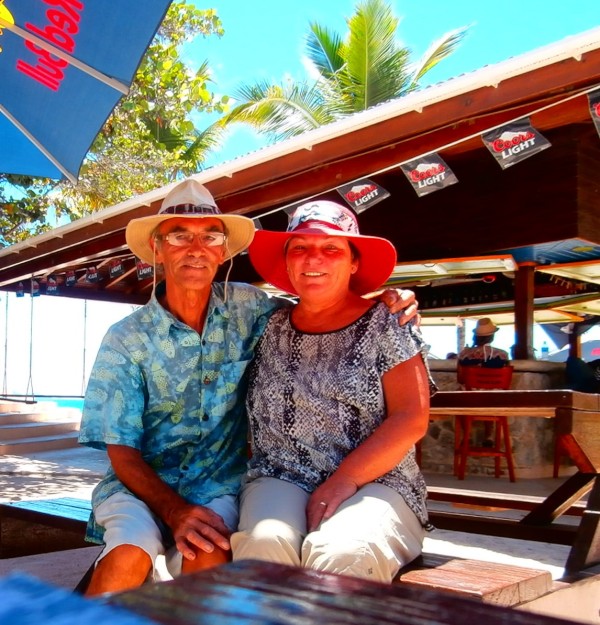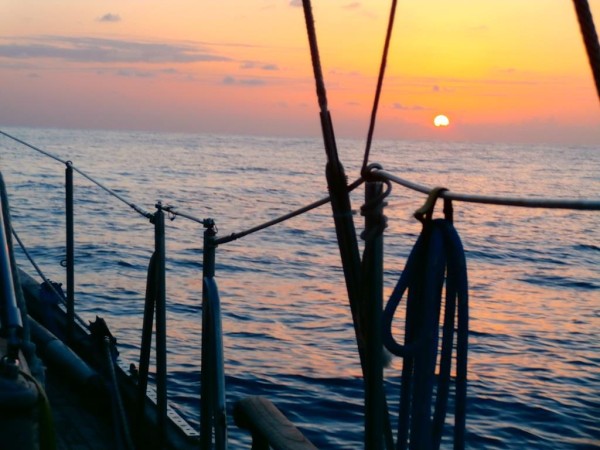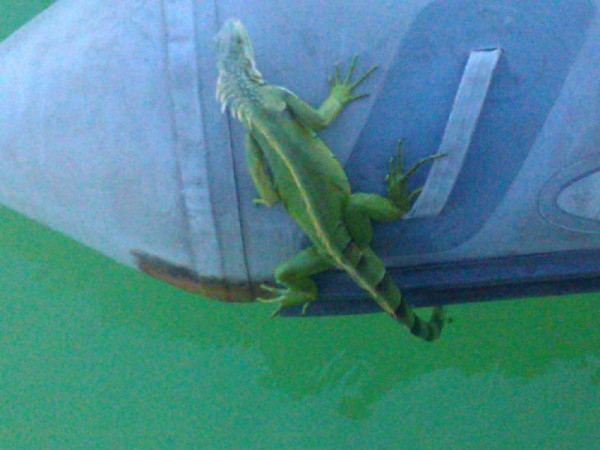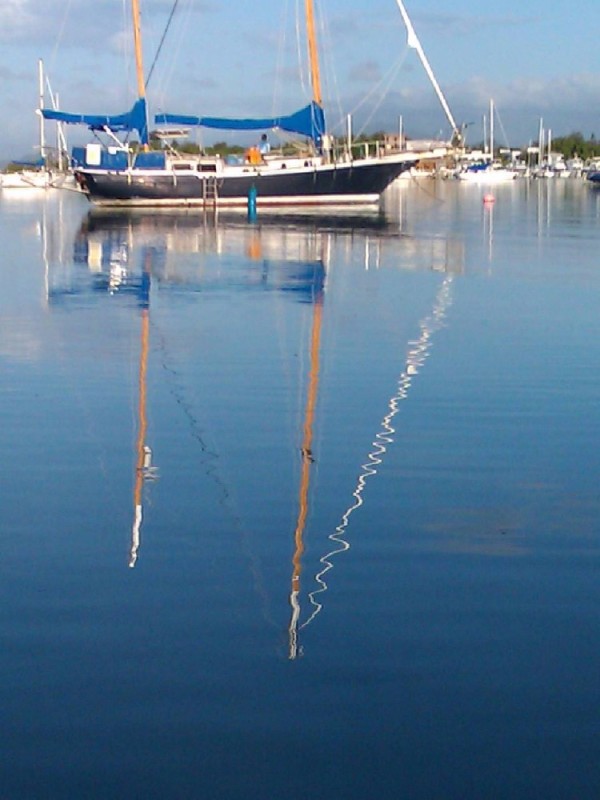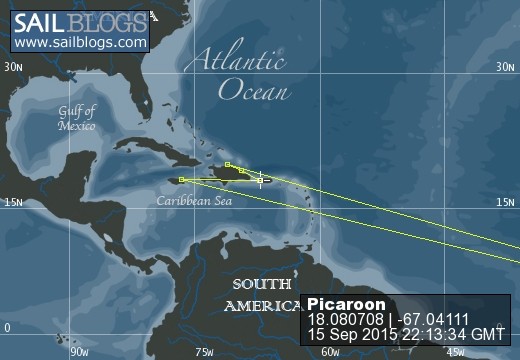
Sailors to seadogs
Jackie & Colins' adventures on the high seas.
09 April 2017
03 April 2017
03 April 2017
29 July 2016
19 July 2016
21 June 2016
20 May 2016
13 March 2016
27 February 2016
27 February 2016
18 November 2015
12 November 2015
27 September 2015
15 September 2015 | Puerto Real Marina
07 September 2015
30 August 2015
30 August 2015
28 July 2015
26 July 2015 | Ile a Vache, Haiti
18 July 2015 | Ila a Vache Haiti
Despair and desperation,
30 August 2015
Now that we’re here safely anchored in Barahona it’s difficult to recall the details of the voyage to reach here, but it was a journey to the depths of ourselves, to the limits of our capacities, to the edge of sanity, and it pushed us beyond our limits as sailors.
On the map it didn’t look very far, perhaps thirty six hours, just one overnight passage to get round the cape called Cabo Beata, and then to head north to Salinas. What we hadn’t factored into the equation were the force of the opposing currents, the constant onslaught of the waves, and the ever present easterly trade winds that we were battling into.
Picaroons engine was to be our means of rounding this cape, and the once around we would sail on to Salinas, about sixty miles to the north east.
We never made it on our first attempt, ending up back at Bahia de Anguillas where we had set out from fifty hours before. That first morning as we rounded the island of Cabo Beata about to turn north we were motoring as the wind was dead on our nose, and using the sails wasn’t an option, or at least that’s what we thought. It was slow progress but we were almost round when the engine gave a cough and a splutter. The temperature gauge shot up off the scale, and the oil pressure took a tumble, something was seriously wrong so we shut down the engine, and hurriedly raised the jib and mizzen and headed off in the only direction we could which was south away from the sharp hard unforbidding coast and out into the tempestuous Caribbean sea.
The further away from land we sailed the bigger the seas became, and the winds increased. This was the last place we wanted to be, the area on the weather maps we poured over before setting sail that were always coloured green, a no go area for us novices, a place which we had vowed to avoid.
With Picaroon being tossed this way and that I went below to see if I could find out what had happened to the engine. I opened the front inspection hatch and spotted what I thought was the problem. One of the fan belts had snapped, the one that runs the water pump. I’ve replaced this belt a few times so the fix was fairly straight forward, albeit awkward, and on a hot engine with the incessant movement of the boat, it was a bit of a trial.
With tools rolling about the cabin, and me being thrown from side to side I somehow managed to get the new belt on. We fired up the engine but to our disappointment the temperature soon soared beyond boiling point. Whatever the problem was this had not fixed it. We checked the raw water outlet at the back end of Picaroon which usually spurts out quite a stream of cooling water to find that there was barely a dribble. This could only mean one thing, the impeller in the sea water pump had failed and would need replacing. We have spares aboard but replacing this is a pig of a job, even in harbor, doing the same job at sea was unthinkable, but would have to be done if we were ever going to get our engine back.
It’s all a bit of a blur, but with Picaroon being steered by our new found crew member, the wind vane, now christened Capt. Morgan, we sailed north hoping to tack back around the cape, but the currents had pushed us too far west and as we came close, too close to land we realized that we wouldn’t make it and had to turn round and head south again or we would literally end up on the rocks. We needed to sail much further south to get the right angle to be able to pass Cabo Beata, and I still had to fix the raw water pump so that we at least had an engine to get us out of trouble.
We had now been out at sea for over two days, and provisions and fresh water were running low, and although we wouldn’t starve, we had only expected this voyage to take twenty four hours. Working into the early hours of the morning I finally fixed the raw water impeller, which actually looked OK apart from one broken fin, but I put in a new one anyway. This still didn’t fix the problem and a certain despair set in until I found the real culprit, a fractured hose that ran close to the exhaust pipe. It had a two inch gash that looked to say the least bad, and unrepairable, it really needed replacing.
I remembered seeing some hose repair tape somewhere, maybe, just maybe we could make a temporary repair, that is, if I could find it. I rummaged around in the forepeak lockers and found it but it looked old, and the instructions said wrap it four inches either side of the hole, but my pipe with its gash only had at best two inches, but it was our only hope of a fix. I used the whole roll, all ten feet of it making as good a job as I thought might work. Once it was back in place and we refilled the fresh water coolant we fired up the engine.
We watched the temperature gauge, and checked the hose, the fix seemed to have worked. It said on the package it was a get you home fix, so we turned off the engine, expecting to only use it when we arrived in Salinas harbor where we would need it to maneuver.
I think at this point we were sailing north again, on our third attempt to get passed the cape which eventually we managed to do on a tack that put us at a more comfortable distance from the coast. At this point we were relieved to be finally around the cape, although making slow progress, when we ran into a large squall that stopped us in our tracks. We had dropped all the sails bar for a sliver of jib and had started the engine hoping to make progress, but after two hours in the storm, and eating up fuel we had gone exactly nowhere, although the fix on the hose seem to be holding, so that was a plus.
Eventually we decided, with much anguish that the only way out of this was to run with the storm, and head south again, giving up all the ground that we had made that day and now we we’re running into our third night and we we’re both worn out having hardly more than dozed in all this time. We set Capt. Morgan to steer, under storm jib, and both went below to escape the torrential rain, and winds, resigned to another night at sea, heading in the wrong direction, south, at four knots, but at least away into open water.
We took hourly watches through the night, and next morning decided that we really had no choice, we we’re both thoroughly exhausted, we would have to head west to a safe anchorage to recover, and to make repairs to Picaroon, one being the teak platform on the bowsprit which had been trashed. We decided to return to Bahia de Anguillas which we had left days ago.
We dropped anchor in the stunning turquoise vastness of this windswept bay glad to be alive, and at last safe. We wept, hugged, and poured ourselves a very stiff couple of drinks before collapsing below. After staying for four or five days, enjoying the grandeur, re-provisioning in nearby Perdernales, we set sail once more for the dreaded Cabo Beata.
On the map it didn’t look very far, perhaps thirty six hours, just one overnight passage to get round the cape called Cabo Beata, and then to head north to Salinas. What we hadn’t factored into the equation were the force of the opposing currents, the constant onslaught of the waves, and the ever present easterly trade winds that we were battling into.
Picaroons engine was to be our means of rounding this cape, and the once around we would sail on to Salinas, about sixty miles to the north east.
We never made it on our first attempt, ending up back at Bahia de Anguillas where we had set out from fifty hours before. That first morning as we rounded the island of Cabo Beata about to turn north we were motoring as the wind was dead on our nose, and using the sails wasn’t an option, or at least that’s what we thought. It was slow progress but we were almost round when the engine gave a cough and a splutter. The temperature gauge shot up off the scale, and the oil pressure took a tumble, something was seriously wrong so we shut down the engine, and hurriedly raised the jib and mizzen and headed off in the only direction we could which was south away from the sharp hard unforbidding coast and out into the tempestuous Caribbean sea.
The further away from land we sailed the bigger the seas became, and the winds increased. This was the last place we wanted to be, the area on the weather maps we poured over before setting sail that were always coloured green, a no go area for us novices, a place which we had vowed to avoid.
With Picaroon being tossed this way and that I went below to see if I could find out what had happened to the engine. I opened the front inspection hatch and spotted what I thought was the problem. One of the fan belts had snapped, the one that runs the water pump. I’ve replaced this belt a few times so the fix was fairly straight forward, albeit awkward, and on a hot engine with the incessant movement of the boat, it was a bit of a trial.
With tools rolling about the cabin, and me being thrown from side to side I somehow managed to get the new belt on. We fired up the engine but to our disappointment the temperature soon soared beyond boiling point. Whatever the problem was this had not fixed it. We checked the raw water outlet at the back end of Picaroon which usually spurts out quite a stream of cooling water to find that there was barely a dribble. This could only mean one thing, the impeller in the sea water pump had failed and would need replacing. We have spares aboard but replacing this is a pig of a job, even in harbor, doing the same job at sea was unthinkable, but would have to be done if we were ever going to get our engine back.
It’s all a bit of a blur, but with Picaroon being steered by our new found crew member, the wind vane, now christened Capt. Morgan, we sailed north hoping to tack back around the cape, but the currents had pushed us too far west and as we came close, too close to land we realized that we wouldn’t make it and had to turn round and head south again or we would literally end up on the rocks. We needed to sail much further south to get the right angle to be able to pass Cabo Beata, and I still had to fix the raw water pump so that we at least had an engine to get us out of trouble.
We had now been out at sea for over two days, and provisions and fresh water were running low, and although we wouldn’t starve, we had only expected this voyage to take twenty four hours. Working into the early hours of the morning I finally fixed the raw water impeller, which actually looked OK apart from one broken fin, but I put in a new one anyway. This still didn’t fix the problem and a certain despair set in until I found the real culprit, a fractured hose that ran close to the exhaust pipe. It had a two inch gash that looked to say the least bad, and unrepairable, it really needed replacing.
I remembered seeing some hose repair tape somewhere, maybe, just maybe we could make a temporary repair, that is, if I could find it. I rummaged around in the forepeak lockers and found it but it looked old, and the instructions said wrap it four inches either side of the hole, but my pipe with its gash only had at best two inches, but it was our only hope of a fix. I used the whole roll, all ten feet of it making as good a job as I thought might work. Once it was back in place and we refilled the fresh water coolant we fired up the engine.
We watched the temperature gauge, and checked the hose, the fix seemed to have worked. It said on the package it was a get you home fix, so we turned off the engine, expecting to only use it when we arrived in Salinas harbor where we would need it to maneuver.
I think at this point we were sailing north again, on our third attempt to get passed the cape which eventually we managed to do on a tack that put us at a more comfortable distance from the coast. At this point we were relieved to be finally around the cape, although making slow progress, when we ran into a large squall that stopped us in our tracks. We had dropped all the sails bar for a sliver of jib and had started the engine hoping to make progress, but after two hours in the storm, and eating up fuel we had gone exactly nowhere, although the fix on the hose seem to be holding, so that was a plus.
Eventually we decided, with much anguish that the only way out of this was to run with the storm, and head south again, giving up all the ground that we had made that day and now we we’re running into our third night and we we’re both worn out having hardly more than dozed in all this time. We set Capt. Morgan to steer, under storm jib, and both went below to escape the torrential rain, and winds, resigned to another night at sea, heading in the wrong direction, south, at four knots, but at least away into open water.
We took hourly watches through the night, and next morning decided that we really had no choice, we we’re both thoroughly exhausted, we would have to head west to a safe anchorage to recover, and to make repairs to Picaroon, one being the teak platform on the bowsprit which had been trashed. We decided to return to Bahia de Anguillas which we had left days ago.
We dropped anchor in the stunning turquoise vastness of this windswept bay glad to be alive, and at last safe. We wept, hugged, and poured ourselves a very stiff couple of drinks before collapsing below. After staying for four or five days, enjoying the grandeur, re-provisioning in nearby Perdernales, we set sail once more for the dreaded Cabo Beata.
Comments
| Vessel Name: | Picaroon |
| Vessel Make/Model: | Hardin Sea Wolf (Formosa 41) |
| Hailing Port: | Luperon Dominican Republic |
| Crew: | Jackie and Colin Williams |
| About: | We had never sailed until September 09 when we went on a RYA Start yachting course in Largs in Scotland. We have this plan to learn how to sail a 36ft boat around the Caribbean, in about 2 years time. 2011/12 now updated to August 2013 |
| Extra: |
Sailors to Seadogs
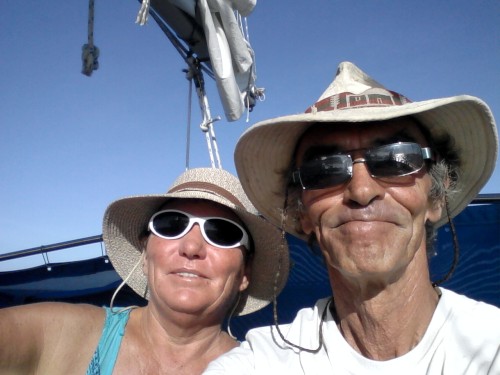
Who: Jackie and Colin Williams
Port: Luperon Dominican Republic

